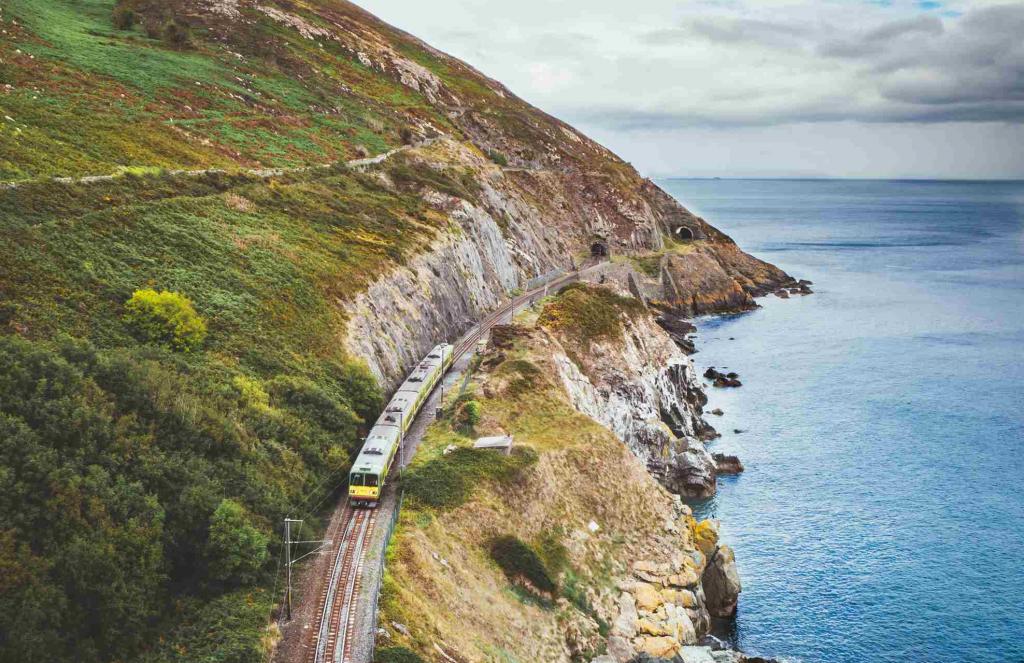Thessaloniki gets ready for its metro launch in November
The underground rapid transit lines have been under construction for almost two decades due to various project delays
 TheMayor.EU logo
TheMayor.EU logo 
Apart from being impractical, the Dublin Rosslare line is incredibly picturesque , Source: Depositphotos
The 150-year-old Dublin-Rosslare train route runs along the eastern coast of the island
Last week Iarnród Éireann (Irish Rail), Ireland’s national rail operator announced it needs 230 million euros to protect the Dublin-Rosslare line from the effects of climate change. The line runs along the east coast of the island, starting from the capital, all the way to the South-East terminus at the small town of Rosslare.
Some sections of the line were built more than 150 years ago and the years of battering by the elements have eroded the coastline and the concrete foundations of the rail line. According to a statement by Iarnród Éireann, the idea behind the renovations was to secure the line for generations to come.
The whole line from Dublin to Rosslare has a length of 168 kilometres and around half is located directly by the sea, vulnerable to climate change. The rail operator has said that funding over the next seven years is supposed to strengthen those particular regions and protect the infrastructure for the next 50 to 100 years.
This includes projects like breakwaters, beach nourishment and onshore revetment strengthening, however, the what and where of these projects will depend on the analysis by Jacobs Engineering, a private company contracted for the first phase of the renovations.
The vulnerable areas are 60 kilometres between Merrion Gates and Wicklow, as well as the 17 kilometres in the Wexford to Rosslare leg. The condition of the line will be examined in the Merrion and Dun Laoghaire, Dalkey Tunnel and Killiney Station, Bray Head and Greystones North Beach, Greystones South and Newcastle, Newcastle to Wicklow as well as at Bray North and Rosslare.
Irish Rail infrastructure Programme Manager Aidan Bermingham, was quoted by the Irish Times, explaining that some older stations are showing severe structural issues, especially when they face the sea.
Additionally, he pointed out that climate-related issues, such as waves washing over the very tracks, have increased in recent years. He also said that their severity has also increased and pointed out that in the past 20 years, there have been more individual cases of climate and weather problems than in the past 100.
Iarnród Éireann corporate communications manager Barry Kenny was quoted by the RTÉ, explaining that coastal railway construction and maintenance have always been challenging. Throughout history, there have been many protective interventions in the line’s infrastructure.
He even said that Irish Rail considered moving the line altogether inland. However, that massive infrastructure project would come with a heavy price tag, so renovations and climate mitigation measures made more sense in both the short term and the next century.

The underground rapid transit lines have been under construction for almost two decades due to various project delays

Now you can get your wine in Talence by paying directly in Bitcoin

That’s because the state has to spend money on updating the railway infrastructure rather than subsidizing the cost of the popular pass

Rethinking renewable energy sources for the urban landscape

The examples, compiled by Beyond Fossil Fuels, can inform and inspire communities and entrepreneurs that still feel trepidation at the prospect of energy transition

Now you can get your wine in Talence by paying directly in Bitcoin

The 10th European Conference on Sustainable Cities and Towns (ESCT) sets the stage for stronger cooperation between the EU, national and local level to fast track Europe's transition to climate neutrality.

At least, that’s the promise made by the mayor of Paris, Anne Hidalgo

The underground rapid transit lines have been under construction for almost two decades due to various project delays

At least, that’s the promise made by the mayor of Paris, Anne Hidalgo

Hostal de Pinós is located in the geographical centre of the autonomous region

Despite its church-y name, the district has long been known as the hangout spot for the artsy crowds

Urban dwellers across the EU are having a say in making their surroundings friendlier to people and the environment.

Forests in the EU can help green the European construction industry and bolster a continent-wide push for architectural improvements.

Apply by 10 November and do your part for the transformation of European public spaces

An interview with the Mayor of a Polish city that seeks to reinvent itself

An interview with the newly elected ICLEI President and Mayor of Malmö

A conversation with the Mayor of Lisbon about the spirit and dimensions of innovation present in the Portuguese capital














